
by Julia Rosen Tuesday, April 19, 2016
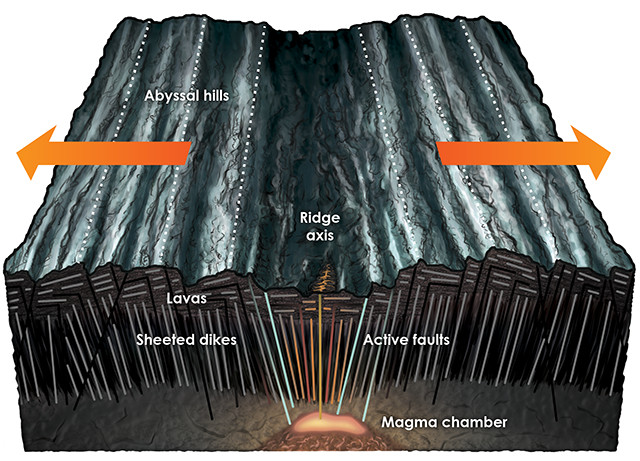
New research suggests that the spacing and elevation of abyssal hills at mid-ocean ridges — traditionally thought to form by faulting — could be correlated with past changes in global sea levels. Credit: K. Cantner, AGI.
At the bottom of every ocean basin lies a chain of submarine mountains. Blanketed in black, pillowy basalt, they tower more than a thousand meters above the seafloor and snake for thousands of kilometers. But instead of having a central spine, like a terrestrial mountain range, these mid-ocean ridges have a central trough from hundreds to thousands of meters wide. This is where — in fiery bursts — new oceanic crust is born.
Recently, these spreading centers have also become the focus of a wide-ranging investigation into possible links between the deep Earth and the ephemeral changes on its surface — namely, whether mid-ocean ridge volcanoes respond to variations in sea level, and whether those volcanoes might influence the climate changes that control sea level. An intense debate over these questions erupted last year, when scientists made a stunning discovery about abyssal hills, the parallel ridges that corrugate vast swaths of the seafloor.
Abyssal hills ripple away from mid-ocean ridges for hundreds of kilometers until they disappear beneath deep-sea sediments, making them the most common landform on the planet. Geologists have long attributed the hills’ existence and appearance to faulting of fresh rock as it cooled and stretched. But when scientists looked closely at the topography of the seafloor, or bathymetry, they noticed that the spacing and elevation of ridges and valleys appeared to correlate with past changes in global sea level.
Researchers proposed that as Earth oscillated between balmy interglacial periods like the present and frigid glacial periods — when ice sheets locked up enough water to lower sea levels by more than 120 meters — changes in the mass of water weighing down on mid-ocean ridges may have altered the amount of magma bubbling out of spreading centers. They suggested that these changes created bands of thicker and thinner crust that contribute to the formation of abyssal hills.
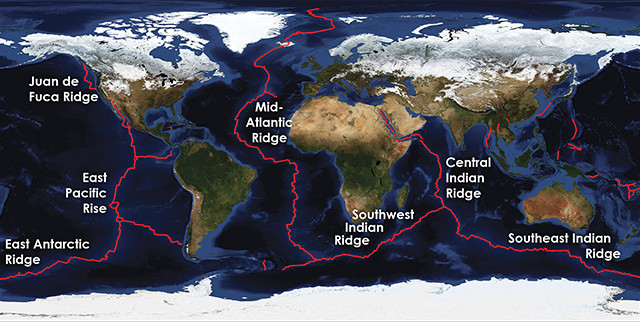
Mid-ocean ridges are found in every ocean basin in the world. They mark the boundary between two tectonic plates that are gradually pulling apart, allowing new oceanic crust to form in between. Credit: K. Cantner, AGI.
The revelation could transform researchers’ understanding of how mid-ocean ridges create new crust, and it suggests that the shape of the seafloor might act as a long-running archive of sea-level change. The research has also caught the attention of climate scientists, who wonder if variations in the amount of carbon dioxide burped out of mid-ocean ridges — induced by changing sea levels — could have played a role in the massive climate changes that drove the planet in and out of ice ages.
However, these ideas remain controversial. Some scientists who specialize in mid-ocean ridges aren’t convinced that abyssal hills are linked to sea-level changes, while others doubt that emissions from submarine volcanoes influenced climate change. Now, a growing body of research aims to help settle these questions.
“Mid-ocean ridges make up the largest volcanic systems on the planet, but they work slightly differently than volcanoes associated with hot spots and subduction zones. In Hawaii, for example, high temperatures in the mantle produce an anomalous supply of magma, while around the Pacific Ring of Fire, water and other compounds released by subducting crust help melt the mantle and fuel eruptions.
At mid-ocean ridges, however, magma forms because two plates are being pulled apart by large-scale tectonic forces like mantle circulation and subduction along distant plate boundaries. The drop in pressure along the ridge axis, where the plates diverge, causes solid mantle rocks to rise and melt. This mechanism, known as decompression melting, provides a fairly steady supply of magma, which erupts as basaltic lava every few years or decades, creating new oceanic crust.
Decompression melting also explains why mid-ocean ridges might respond to sea-level changes. Drops in sea level should reduce the pressure on mid-ocean ridges and increase magma production, whereas rising sea levels would increase pressure and reduce magma production. These changes might seem too small to matter, but that’s not the case, according to a 2015 study published in Science.
Researchers led by Richard Katz, a geodynamicist at Oxford University in England, modeled how the most rapid sea-level changes in the last million years would have affected mid-ocean ridges and found that they could have boosted or suppressed magma production by about 10 percent during the course of a glacial cycle. “That’s not a small difference,” Katz says. “Ten percent variations in melting rate should be observable.” If these variations alter how much magma erupts at the surface, they could influence the topography of the seafloor by changing how much lava builds up next to the spreading center before the crust migrates away, potentially explaining the existence of abyssal hills.
The team says they’ve found evidence of this process in the pattern of hills along the Australian-Antarctic Ridge, which was recently mapped in enough detail to discern individual ridges. The scientists chose this site because it is an intermediate-rate spreading center, where their model suggests climate changes would have a strong impact on magma production, and where it should be easier to disentangle the effects of volcanism from faulting, which they acknowledge plays some role in creating abyssal hills.
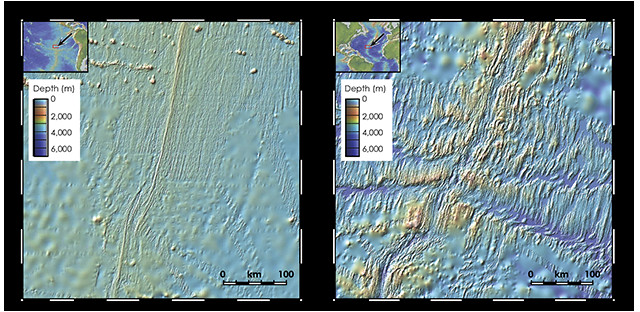
Abyssal hills are long topographic highs that form parallel to mid-ocean ridges. Scientists have long attributed the spacing of hills to faulting, but now, some think sea-level changes may have also played a role. Credit: GeoMapApp.
The team used the spreading rate along the ridge — which remains relatively constant at 3 centimeters per year — to convert the distance that a given line of hills sits from the plate boundary into its age. And just as their model of mantle melting predicted, Katz and his colleagues found that hills seemed to form about every 23,000, 41,000 and 100,000 years.
These numbers are familiar to climate scientists as the durations of Milankovitch Cycles, the periods over which the major characteristics of Earth’s orbit — the eccentricity, and the tilt and wobble of its axis — vary like clockwork. For decades, researchers have recognized that these orbital changes impact how the sun’s energy hits Earth, driving sweeping changes in global climate and sea level, most strongly at the 100,000-year periodicity.
Finding the same frequencies in the ages of abyssal hills suggests that the impacts of these changes on the surface extend all the way to the seafloor, Katz says. “Either that’s a coincidence, or somehow the topography is being influenced by sea-level change.”
" a comment in Science in response to Katz’s study.
That’s why Goff and other critics of the new sea-level hypothesis say that proponents must reconcile an enhanced role for volcanism with the tectonic processes already known to affect the topography of the seafloor. If changing sea level altered the amount of magma erupting at mid-ocean ridges, and if these variations left a record in the topography of abyssal hills, Goff says, “it would really have to be a secondary signal, as opposed to a primary signal.”
One specific point of contention for Goff is that the sea-level hypothesis makes a prediction that appears to contradict much of the existing data on mid-ocean ridges. Specifically, it suggests that global changes in sea level should produce hills that are farther apart at fast spreading centers — where new crust migrates more quickly away from the plate boundary — than at slower spreading centers. However, previous studies have shown just the opposite: Faster spreading centers have more closely spaced abyssal hills, in agreement with models of seafloor faulting.
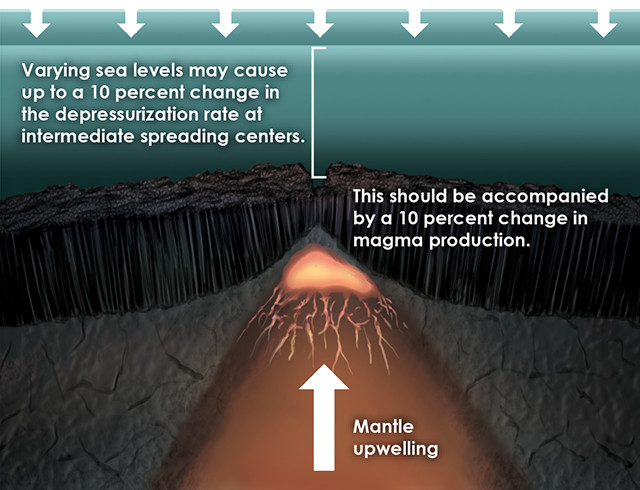
According to Richard Katz and his colleagues, sea-level changes could affect magmatism at mid-ocean ridges. Credit: K. Cantner, AGI, and Julia Rosen.
Katz’s results from the Australian-Antarctic Ridge, an intermediate-rate spreading center, don’t confirm or contradict this trend; the dominant 100,000-year signal in his team’s data falls in line with observations of hill spacing at other intermediate-rate spreading centers. But that could simply be a coincidence, says Jean-Arthur Olive, a geophysicist at Columbia University’s Lamont-Doherty Earth Observatory (LDEO) who, along with co-authors, published a rebuttal paper in Science in the fall of 2015. Olive’s team modeled the forces that control fault spacing at mid-ocean ridges — including the supply of magma and the strength of the lithosphere — and found that hills at intermediate-rate spreading centers should be roughly 100,000 years apart.
However, Olive insists he and other critics aren’t trying to shut down the sea-level hypothesis. Indeed, he says it’s plausible that variations in sea level influenced magma production at mid-ocean ridges. The question is whether such changes would lead to variations in the topography of the seafloor, or whether any extra magma would simply glom onto the bottom of the crust. Olive’s model suggests the latter scenario may be more likely, but it could only be confirmed by looking at total crustal thickntric to measure than bathymetry.
In the meantime, Olive says that his model could help researchers identify possible sea-level signals by predicting the fault spacing at various locations. If researchers find different patterns at ridges spanning a range of spreading rates, and at multiple spots along the same ridge, it could help confirm the role of sea-level changes. Last December, atg of the American Geophysical Union in San Francisco, scientists reported preliminary evidence to support Katz’s results, but mostly from other intermediate-rate spreading centers.
One place such a signal has already been detected is at the Southern East Pacific Rise off the west coast of South America, where the Pacific and Nazca plates pull apart at almost 15 centimeters per year, making it the fastest spreading center on the planet. There, Maya Tolstoy of LDEO has found evidence for abyssal hills spaced 100,000 years apart. According to Olive’s model, that is not a frequency that faulting at fast spreading centers should produce. It is, however, the frequency with which Earth marched in and out of ice ages, causing the most dramatic changes in sea level.
“Tolstoy has studied the mysterious behavior of undersea volcanoes for more than a decade. “We know very little about mid-ocean ridges because they are hard to study,” she says. “You don’t see them and you don’t hear them, for the most part.” So she and her colleagues started monitoring eruptions by listening for earthquakes, and over time, she noticed a pattern. Eruptions happened more frequently during neap tides — when local sea levels were lower — and during the first half of the calendar year.
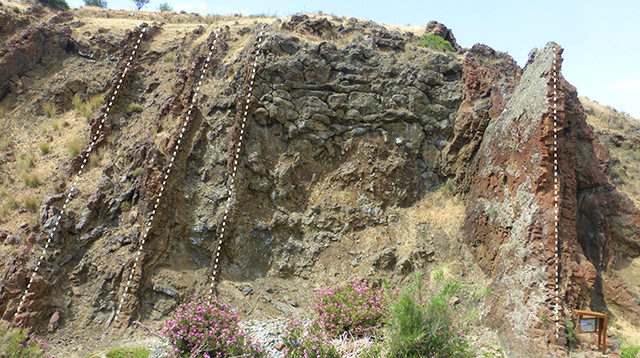
Much of the oceanic crust created at mid-ocean ridges consists of magma that was never erupted at the surface, like these so-called sheeted dikes (white dotted lines), now exposed in the Troodos Mountains of Cyprus. Credit: Lon Abbott and Terri Cook.
Tolstoy hypothesized that this tendency could stem from the fact that Earth’s orbit is not perfectly circular, but oval-shaped, and between January and June the planet moves father away from the sun. During this time, the impact of the sun’s gravitational pull gradually weakens. “It’s essentially when the squeeze of the sun on Earth is lessening slightly,” Tolstoy says. She thinks this modest release might unload Earth’s crust enough to encourage eruptions more during the first half of the year than the second.
Tolstoy’s observations got her wondering about the past, when both sea level and the shape of Earth’s orbit fluctuated more dramatically. In 2008, she submitted a paper and a grant proposal to explore the idea in more detail. Tolstoy had a hard time getting either accepted — perhaps, she says, because the topic was so controversial — so she put the work on hold until recently. In her manuscripts, Tolstoy hypothesized that variations in sea level, driven by climate changes, could alter magma production at mid-ocean ridges. She also thought there could be a direct influence of Earth’s orbit on mid-ocean ridges. At the peak of the last glacial period about 20,000 years ago — when sea level was lowest — Earth’s orbit was more eccentric. That may have caused more intense squeezing and unloading of the crust, she says, and promoted more frequent eruptions. These eruptions could then have helped release the excess magma that had built up beneath mid-ocean ridges due to lower sea levels.
Tolstoy looked for potential evidence in the bathymetry of the Southern East Pacific Rise, where she found hills separated by 100,000-year spacing. She published her results last year in Geophysical Research Letters the same day that Katz’s study came out in Science. But Tolstoy says there is a difference between the two studies. Although finding a pattern in the spacing of abyssal hills supported her idea, “my hypothesis doesn’t require that anything be observed in the seafloor topography,” she says. She clarifies that her hypothesis predicts that sea-level changes should affect volcanism, not whether changes in volcanism contribute to the formation of abyssal hills.
This idea seems to be supported by new results from University of Connecticut oceanographer David Lund and his colleagues. In 2008, Lund and Paul Asimow, a geologist at Caltech, began to model how changes in sea level might affect mid-ocean ridges, a hypothesis they detailed in a 2011 paper. But instead of turning to seafloor bathymetry for supporting evidence, Lund and his collaborators took an alternative approach, analyzing seafloor sediment cores for clues to past changes in volcanic activity. Specifically, they looked for evidence of increased emissions from hydrothermal vents, which gush geothermally heated fluids laden with iron, manganese and other metals that collect on the seafloor.
In early 2016, Lund and his colleagues published a study in Science reporting results from a suite of cores at the Southern East Pacific Rise. They found pronounced peaks in the concentrations of hydrothermal metals approximately 15,000 and 130,000 years ago, during the last two deglaciations, suggesting that these changes in climate coincided with periods of elevated volcanic activity. There’s still a great deal more work to be done, Lund says, but the results provide tentative support for a link between major climate changes and magmatism at mid-ocean ridges.
As for whether these changes left a mark in the bathymetry, Lund says researchers still need to tease apart the relative roles of faulting and volcanism in producing abyssal hills. However, Lund says the community will have to work out some kind of an explanation if sediment cores and bathymetric data both show evidence for pulses of activity in response to sea-level changes. “While we may not understand what causes it exactly, in terms of the detailed mechanism,” he says, “I find it hard to believe that you would find Milankovitch-scale periodicities by chance.” And if researchers start seeing such signals in multiple locations, as some preliminary results suggest, “that becomes really hard to explain away.”
“, a geologist at Harvard University and a co-author on Katz’s 2015 study. Although such a link was not mentioned in that paper, Huybers has since started to explore whether mid-ocean ridges might help explain the mysterious pacing of the ice ages.
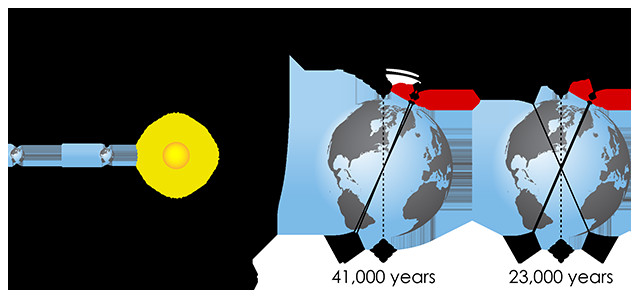
In the 1920s, Milutin Milankovitch theorized that variations in Earth's orbit caused ice ages. He was one of the first to calculate how changes in Earth's eccentricity, obliquity and precession would affect the intensity and distribution of solar energy hitting the planet, and whether they could drive massive global climate changes. Credit: K. Cantner, AGI.
The 100,000-year periodicity of glaciations, and their coincidence with 100,000-year variations in the eccentricity of Earth’apparent to researchers decades ago, but the exact cause of this cyclicity remains unclear. Scientists have long known that eccentricity does not alter the amount of solar radiation reaching Earth enough to drive the planet in and out of glacial periods on its own. As a result, researchers have sought alternative explanations for the tempo of Earth’s climate metronome and have searched for feedbacks that might amplify small orbital changes into dramatic ones.
Carbon dioxide is the most powerful feedback scientists have discovered. Ice-core records reveal that its concentration has varied by more than 50 percent between glacial and interglacial periods — enough to substantially alter climate. But researchers continue to debate where this carbon dioxide came from when Earth warmed, and where it went during ice ages. Most scientists suspect carbon moved between the atmosphere and the deep ocean through some combination of changes in ocean chemistry, biology and circulation. Volcanoes are another major source of carbon dioxide, but geologists had not considered their influence on climate over timescales of thousands of years — a geologic instant — until recently.
In 2009, Huybers published a paper with Harvard colleague Charlie Langmuir on how shrinking ice sheets affected land-based volcanoes at the end of the last ice age. They suggested that unloading of continental crust could have induced decompression melting that spurred more eruptions, producing enough carbon dioxide to help propel Earth into the current interglacial period. At the time, the researchers thought mid-ocean ridges would have a minor effect on climate, but now, Huybers says, scientists have started to realize they are much more complicated, and potentially more interesting.
That’s because there’s likely to be a long delay between the timing of sea-level changes and when the magma created by those changes actually erupts at a spreading center. Estimates for how fast magma can rise and erupt vary greatly, but research suggests that the lag could span anywhere from thousands to tens of thousands of years. This sets submarine volcanoes apart from the kinds of fast-changing processes — like ocean circulation and biology — that climate scientists have previously invoked to explain glacial-interglacial changes in carbon dioxide, Huybers says.

Variations in orbital eccentricity (red line, top) influence the amount of solar energy, or insolation (orange line), received on Earth. Changes in insolation at high northern latitudes, shown here for the past 500,000 years, are thought to be particularly important in driving the growth and decay of large Northern Hemisphere ice sheets and pacing the ice ages. Glacial cycles were marked by huge changes in Earth's climate. For instance, during glacial periods, ice cores from Antarctica indicate that temperatures were up to 10 degrees Celsius colder than present (brown line). Dramatic changes in sea level (thick blue line) accompanied these climate changes, as the amount of water locked up in ice sheets varied. Scientists think that atmospheric carbon dioxide (light blue dots) plays an important role in driving global climate changes, although they continue to debate where carbon dioxide came from during deglacial warming events and where it went during cold glacial periods. Credit: K. Cantner, AGI, and Julia
And depending on the length of the delay, the impacts of mid-ocean ridge emissions on climate could differ dramatically. One possibility is that the link between sea-level variations and mid-ocean ridges has a stabilizing effect on climate change. This would happen if, for instance, rising sea levels during deglaciation set in motion a chain of events that suppressed volcanism, lowering atmospheric carbon dioxide and slowing warming. However, if the delay were longer, the feedback might instead cause Earth’s climate to oscillate, Huybers says. For example, if the decrease in volcanic carbon dioxide — triggered by rising sea levels at the end of an ice age — comes when Earth has already started to cool again, it could accelerate that trend, pitching Earth back into a glacial period.
This latter scenario is tentatively supported by the results of a recent study in Earth and Planetary Science Letters, by Katz and Jonathan Burley, a doctoral student at Oxford. The pair modeled how variations in sea level would affect not only magma production, but also magma geochemistry, including how much carbon dioxide it contains. Then they calculated how carbon dioxide emissions from mid-ocean ridges would vary during a glacial cycle — and how long it would take to see those changes. Although hampered by uncertainties in the rate at which magma rises through the mantle, the researchers found that changes in carbon dioxide emissions from mid-ocean ridges should lag behind sea-level changes by 50,000 years or more.
Katz and Burley estimate only a 12 percent change in carbon emissions from mid-ocean ridges over a glacial-interglacial cycle — and models suggest even less would escape from the ocean to the atmosphere. However, Huybers says, “it doesn’t really take a very strong negative delayed feedback to make it more likely for a system to oscillate.” Huybers is currently finishing up a paper that tries to flesh out how such a delayed response might help explain the mysterious pacing of climate cycles, But for now, he says, there are still “some really big outstanding questions.”
" of LDEO and a team of researchers sailed to the Juan de Fuca Ridge, a spreading center off the coast of Oregon and Washington, to collect sediment cores. Huybers and others have found additional evidence for climate signals in the spacing of abyssal hills near this ridge. Like Lund, McManus and his colleagues are looking at the concentration of metals in their cores to understand whether hydrothermal activity at the ridge has changed over time. Although their work is still in progress, McManus says their preliminary results seem to broadly agree with Lund’s: that volcanic activity changed during glacial cycles.
Because sediments are relatively easy to date, McManus hopes that this work can help constrain the time lag between sea-level changes and the response at mid-ocean ridges, which is essential to understanding the climate impact. For instance, researchers are still trying to understand whether it’s sea level itself, or its rate of change, that affects mid-ocean ridges, while Tolstoy’s hypothesis suggests that eccentricity may be a common driver for both. “Our approach is not to look at a single glaciation,” he says, but to use the cores’ long memory to get a more robust answer by looking back at many glacial cycles. “Does it happen again and again and again?” he asks.
McManus also hopes the cores can help elucidate exactly how changes in volcanic activity might have affected climate. Although Huybers and others have focused on carbon dioxide, some people say a burst of volcanic emissions may not fit with what scientists know about the ocean carbon cycle. For example, Robert Anderson, a geochemist at LDEO, says that the addition of volcanic carbon dioxide would have acidified the deep ocean, just as human emissions are doing today. But “the sedimentary record is unequivocal that deep ocean chemistry went the other direction,” he says.
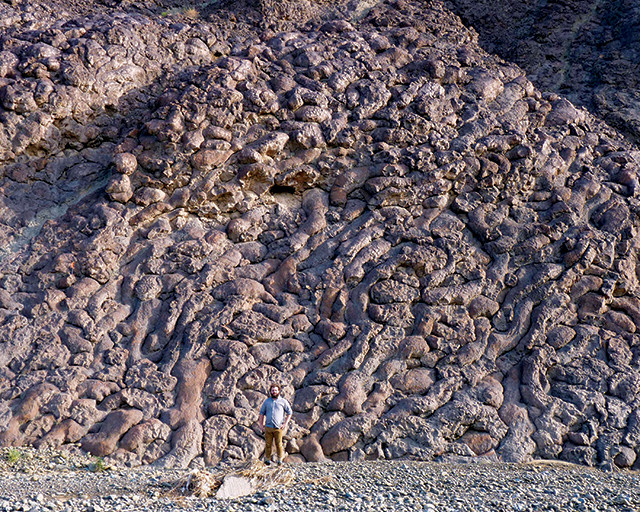
Fed by the dikes beneath, pillow basalts, like these exposed in Oman, form as magma erupts into cold seawater. Credit: Chuck Bailey.
Until researchers learn more, McManus says they should remain open to all possible links between mid-ocean ridge volcanism and climate. For instance, Lund has suggested that heat released by hydrothermal vents might alter ocean circulation and McManus is exploring the possible impacts of a spike in the concentrations of volcanic metals like iron. An increase in the availability of the micronutrient could have fueled the growth of plankton, which pull carbon dioxide out of the atmosphere during photosynthesis and transfer it to the deep ocean when the organisms die and sink.
These are the kinds of questions that must be answered before climate scientists can understand if mid-ocean ridge volcanism had a hand in Earth’s climate cycles, and whether climate left its mark across the global seafloor. McManus doesn’t know what the answers will be in the end, but he’s glad researchers are finally exploring such links. “These earth systems are all connected,” he says. “So it doesn’t at all surprise me that there are interactions.”
© 2008-2021. All rights reserved. Any copying, redistribution or retransmission of any of the contents of this service without the expressed written permission of the American Geosciences Institute is expressly prohibited. Click here for all copyright requests.